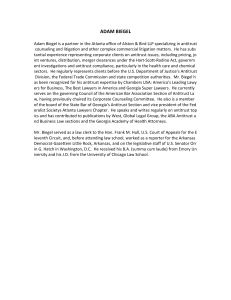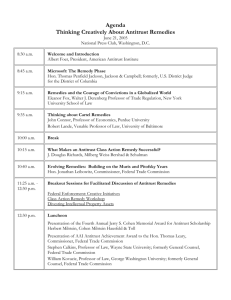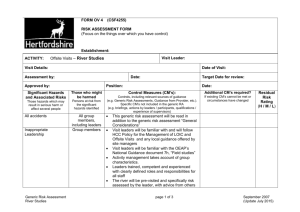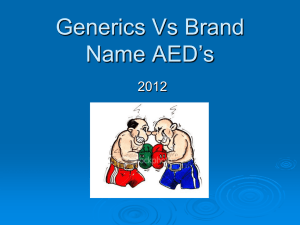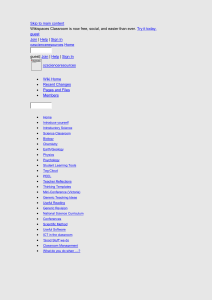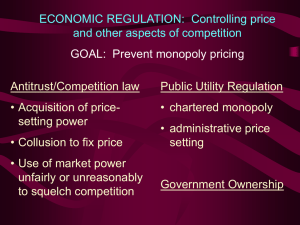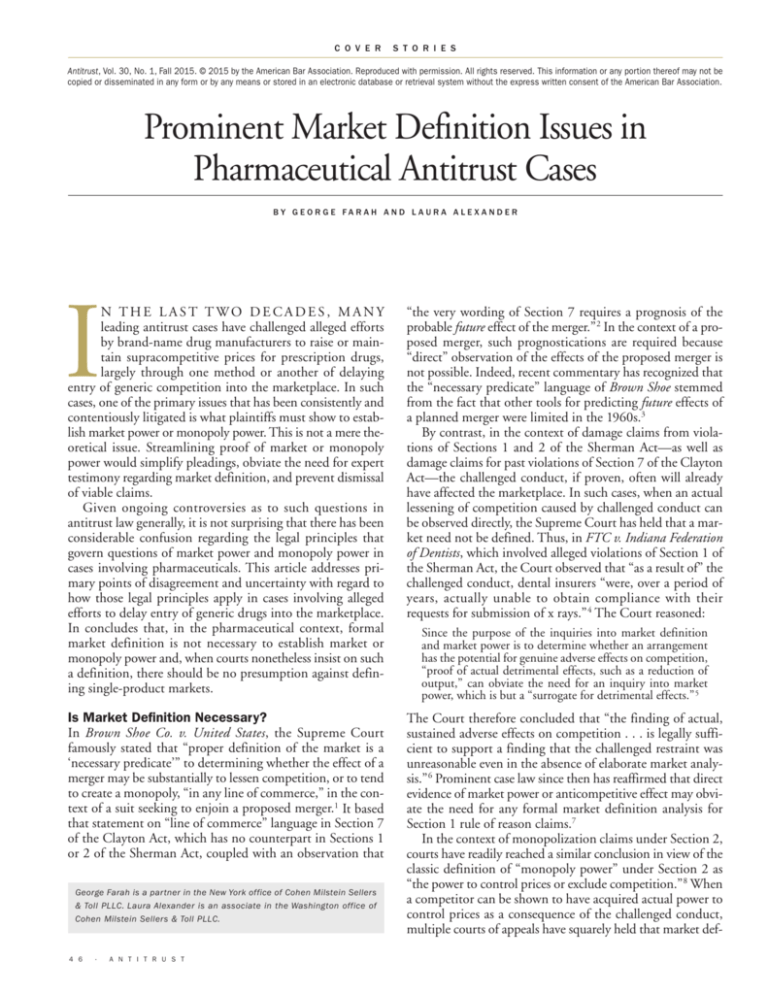
C O V E R
S T O R I E S
Antitrust, Vol. 30, No. 1, Fall 2015. © 2015 by the American Bar Association. Reproduced with permission. All rights reserved. This information or any portion thereof may not be
copied or disseminated in any form or by any means or stored in an electronic database or retrieval system without the express written consent of the American Bar Association.
Prominent Market Definition Issues in
Pharmaceutical Antitrust Cases
B Y G E O R G E FA R A H A N D L A U R A A L E X A N D E R
I
N THE LAST TWO DECADES, MANY
leading antitrust cases have challenged alleged efforts
by brand-name drug manufacturers to raise or maintain supracompetitive prices for prescription drugs,
largely through one method or another of delaying
entry of generic competition into the marketplace. In such
cases, one of the primary issues that has been consistently and
contentiously litigated is what plaintiffs must show to establish market power or monopoly power. This is not a mere theoretical issue. Streamlining proof of market or monopoly
power would simplify pleadings, obviate the need for expert
testimony regarding market definition, and prevent dismissal
of viable claims.
Given ongoing controversies as to such questions in
antitrust law generally, it is not surprising that there has been
considerable confusion regarding the legal principles that
govern questions of market power and monopoly power in
cases involving pharmaceuticals. This article addresses primary points of disagreement and uncertainty with regard to
how those legal principles apply in cases involving alleged
efforts to delay entry of generic drugs into the marketplace.
In concludes that, in the pharmaceutical context, formal
market definition is not necessary to establish market or
monopoly power and, when courts nonetheless insist on such
a definition, there should be no presumption against defining single-product markets.
“the very wording of Section 7 requires a prognosis of the
probable future effect of the merger.” 2 In the context of a proposed merger, such prognostications are required because
“direct” observation of the effects of the proposed merger is
not possible. Indeed, recent commentary has recognized that
the “necessary predicate” language of Brown Shoe stemmed
from the fact that other tools for predicting future effects of
a planned merger were limited in the 1960s.3
By contrast, in the context of damage claims from violations of Sections 1 and 2 of the Sherman Act—as well as
damage claims for past violations of Section 7 of the Clayton
Act—the challenged conduct, if proven, often will already
have affected the marketplace. In such cases, when an actual
lessening of competition caused by challenged conduct can
be observed directly, the Supreme Court has held that a market need not be defined. Thus, in FTC v. Indiana Federation
of Dentists, which involved alleged violations of Section 1 of
the Sherman Act, the Court observed that “as a result of” the
challenged conduct, dental insurers “were, over a period of
years, actually unable to obtain compliance with their
requests for submission of x rays.” 4 The Court reasoned:
Is Market Definition Necessary?
In Brown Shoe Co. v. United States, the Supreme Court
famously stated that “proper definition of the market is a
‘necessary predicate’” to determining whether the effect of a
merger may be substantially to lessen competition, or to tend
to create a monopoly, “in any line of commerce,” in the context of a suit seeking to enjoin a proposed merger.1 It based
that statement on “line of commerce” language in Section 7
of the Clayton Act, which has no counterpart in Sections 1
or 2 of the Sherman Act, coupled with an observation that
The Court therefore concluded that “the finding of actual,
sustained adverse effects on competition . . . is legally sufficient to support a finding that the challenged restraint was
unreasonable even in the absence of elaborate market analysis.” 6 Prominent case law since then has reaffirmed that direct
evidence of market power or anticompetitive effect may obviate the need for any formal market definition analysis for
Section 1 rule of reason claims.7
In the context of monopolization claims under Section 2,
courts have readily reached a similar conclusion in view of the
classic definition of “monopoly power” under Section 2 as
“the power to control prices or exclude competition.” 8 When
a competitor can be shown to have acquired actual power to
control prices as a consequence of the challenged conduct,
multiple courts of appeals have squarely held that market def-
George Farah is a partner in the New York office of Cohen Milstein Sellers
& Toll PLLC. Laura Alexander is an associate in the Washington office of
Cohen Milstein Sellers & Toll PLLC.
4 6
·
A N T I T R U S T
Since the purpose of the inquiries into market definition
and market power is to determine whether an arrangement
has the potential for genuine adverse effects on competition,
“proof of actual detrimental effects, such as a reduction of
output,” can obviate the need for an inquiry into market
power, which is but a “surrogate for detrimental effects.” 5
inition is not necessary for a Section 2 claim.9 Leading commentators have largely agreed.10 In particular, at least three
prominent authorities have recently raised compelling theoretical challenges to the notion that formal market definition
is useful to antitrust analysis when market power can already
be shown based on direct, historical evidence.11
In the specific context of antitrust litigation involving
claims of delayed generic entry, principles that support dispensing with any formal market definition requirements
apply even more clearly. When a generic drug comes to market, the price that can be charged for the brand-name drug
invariably plummets by a substantial margin.12 When generic entry has this price effect in the marketplace, some courts
have expressly recognized that the observed price effect by
itself can establish market or monopoly power, without a
need for formal market definition.13 Furthermore, even when
no generic competitor has yet entered the market, some
courts have recognized that the frequency with which generic drug entry sharply depresses brand-name drug prices may
justify a factfinder in concluding that the brand-name company exercises market power prior to generic entry.14
Is Functional Substitutability Enough to Warrant
Inclusion in the Same Product Market?
Despite the principles outlined above and their clear support
in the Supreme Court’s decision in Indiana Federation of
Dentists, some lower courts have continued to treat formal
market definition as though it were a necessary step in establishing market power or monopoly power in pharmaceutical
antitrust cases.15 In many of these cases it is questionable
whether any genuine market definition analysis is required,
as distinguished from analysis of direct evidence of market
power, since the basis for the market definition is often merely the observation that market power exists.16
These cases illustrate one of the principal points made by
Professor Louis Kaplow in recent scholarship, that much of
what passes for “market definition” analysis is really nothing
more than “a purely results-oriented market definition stratagem under which one first determines the right legal answer”
based on direct observations about market power “and then
announces a market definition that ratifies it.” 17 In such
cases, it would be more accurate to recognize that the basis
of the analysis is reliance on direct evidence of market power,
rather than any genuine formal market definition analysis,
and that adherence to any requirement of “market definition”
only tends to obscure the real issues in play.
Nevertheless, when courts have required proof of the relevant market in pharmaceutical antitrust cases, fact issues frequently arise as to whether other drugs in the same therapeutic class should be included in the relevant product
market with the drugs at issue in the case.
The Supreme Court has defined monopoly power innumerable times as “the power to control prices or exclude competition.” The fact that two products may be substituted for
one another functionally should therefore have no bearing on
the presence of market power or monopoly power, absent evidence that such substitutability eliminates the power to control prices.18 By extension, two drugs in the same therapeutic class should not be considered part of the same product
market if competition from the second drug fails to trigger
competitive pricing for the first drug. Accordingly, many
cases in the pharmaceutical context have limited the relevant
antitrust market to the branded and generic versions of a single formulation of a single drug, even when other drugs within the same therapeutic class have been available.19
Courts in a few other cases have reached the opposite
conclusion, in our view based on a misconception as to when
mere functional substitutes should be excluded from the relevant market.20 This confusion arises in part from the ABA
Model Jury Instructions, which state (erroneously, we believe)
that different products should be included in the same product market whenever they are “reasonable alternatives,” without regard to whether competition from one product prevents the manufacturer of the other from raising prices above
a competitive level.21 This approach to market definition is
analytically inappropriate because it does not focus on the
drug maker’s “power to control price,” which is the touchstone for determinations of market and monopoly power.
In the specific context of antitr ust litigation
involving claims of delayed generic entr y, principles
that suppor t dispensing with any for mal mar ket
definition requirements apply even more clear ly.
“Single Brand” Markets
When successful marketing permits a competitor to raise
prices on its products even though others produce essentially identical products, some courts have found it inappropriate to define the successful brand by itself as a distinct product market. Accordingly, in non-pharmaceutical antitrust
cases, “single brand” markets have been generally disfavored
when the products being considered for inclusion in the market are essentially identical.22
It makes no sense to apply these principles, however, where
differences among products do not merely involve brand
names but instead are substantive differences that stem from
patent or copyright protection. Thus, in Fortner Enterprises,
the Supreme Court recognized that one manufacturer’s product can confer economic power “when other competitors are
in some way prevented from offering the distinctive product
themselves. Such barriers may be legal, as in the case of
patented and copyrighted products.” 23
In most pharmaceutical antitrust cases, the branded drug
maker has unexpired patents on the branded drug, along
with corresponding regulatory limitations on the manufacF A L L
2 0 1 5
·
4 7
C O V E R
ture and sale of competing generic drugs under the HatchWaxman Act. Thus, differences between the brand-name
drug and its generic equivalents, on the one hand, and other
drugs in the same therapeutic class, on the other, are not mere
branding differences but instead are substantive differences
stemming from ways in which the law prevents competing
producers “from offering the distinctive product themselves.”
Moreover, prescriptions that physicians write for a particular
brand-name drug may be filled with a generic equivalent
but not by a different drug in the same class. Accordingly,
consistent with the Fortner decision, presumptions against
“single brand markets” should not apply in pharmaceutical
antitrust cases, as some courts have recognized.24
Nonetheless, some courts have applied a presumption
against “single brand markets” in pharmaceutical antitrust
cases even when controlling law—including patent law protection for the brand-name product—prevents rival drug
makers in the same drug class from offering a product identical to the branded drug at issue in the case.25 These rulings
in our view misapply the presumption against “single brand
markets,” which should apply only where there is no legal
hindrance to competing producers selling the same product
as the brand in question.
S T O R I E S
Trading Co., 381 F.3d 717, 736–37 (7th Cir. 2004); Toys “R” Us, Inc. v. FTC,
221 F.3d 928, 937 (7th Cir. 2000).
8
Eastman Kodak Co. v. Image Technical Servs., Inc., 504 U.S. 451, 481
(1992) (monopoly power is the “power to control prices or exclude competition”) (citation omitted).
9
Broadcom Corp. v. Qualcomm Inc., 501 F.3d 297, 307 & n.3 (3d Cir. 2007)
(stating in Section 2 case that “direct proof of monopoly power does not
require a definition of the relevant market”); Heerwagen v. Clear Channel
Commc’ns, 435 F.3d 219, 227 (2d Cir. 2006) (stating in Section 2 case that
“[i]ndirect proof of market power, that is, proof that the defendant has a
large percentage share of the relevant market, is [merely] a ‘surrogate’ for
direct proof of market power” when direct evidence is not available or is
ambiguous), overruled on other grounds by In re IPO Securities Litig., 471
F.3d 24, 42 (2d Cir. 2006); see also King Drug, 791 F.3d at 412; PepsiCo.,
Inc. v. Coca-Cola Co., 315 F.3d 101, 107 (2d Cir. 2002); Re/Max Int’l, Inc.
v. RealtyOne, Inc., 173 F.3d 995, 1026 (6th Cir. 1999); Rebel Oil Co. v. Atl.
Richfield Co., 51 F.3d 1421, 1434 (9th Cir. 1995); United States v.
Microsoft Corp., 253 F.3d 34, 51 (D.C. Cir. 2001).
10
See A NDREW I. G AVIL , W ILLIAM E. K OVACIC & J ONATHAN B. B AKER , A NTITRUST
L AW IN P ERSPECTIVE 919 (2d ed. 2008) (“[E]vidence of the actual ability
. . . [to] raise prices . . . establishes market power . . . and it may do so more
reliably than market share evidence.”); L AWRENCE A. S ULLIVAN & WARREN S.
G RIMES , T HE L AW OF A NTITRUST 74 (2d ed. 2006) (“Disputes about market
definition . . . are of little consequence in the face of actual evidence of anticompetitive effects.”); Phillip Areeda, Market Definition and Horizontal
Restraints, 52 A NTITRUST L.J. 553, 565 (1983) (“[M]arket definition and
market shares are second best to direct measurement.”).
11
Louis Kaplow, Why (Ever) Define Markets?, 124 H ARV. L. R EV. 437, 440
(2010) [hereinafter Kaplow, Why (Ever) Define Markets? ]; U.S. Dep’t of
Justice & Fed. Trade Comm’n Horizontal Merger Guidelines § 2.1.2 (2010),
http://www.ftc.gov/os/2010/08/100819hmg.pdf; Herbert Hovenkamp,
Markets in Merger Analysis; Merger Policy, Structuralism, and the Legacy of
Brown Shoe, 57 A NTITRUST B ULL . 887; see also J. Douglas Richards, Is
Market Definition Necessary in Sherman Act Cases When Anticompetitive
Effects Can Be Shown with Direct Evidence?, A NTITRUST , Summer 2012, at
53–59 (discussing these three authorities at greater length); Louis Kaplow,
Market Definition: Impossible and Counterproductive, 79 A NTITRUST L.J. 361
(2013) (elaborating on prior work and subsequent response); Daniel A.
Crane, Market Power Without Market Definition, 90 N OTRE D AME L. R EV. 31
(2014) (proposing framework for market power analysis in a post-market
definition world). But see Gregory J. Werden, Why (Ever) Define Markets?
An Answer to Professor Kaplow, 78 A NTITRUST L.J. 729 (2014); Gregory J.
Werden, The Relevant Market: Possible and Productive, http://www.
americanbar.org/content/dam/aba/publishing/antitrust_law_journal/at_
alj_werden.aut hcheckdam.pdf.
12
See Eric L. Cramer & Daniel Berger, The Superiority of Direct Proof of
Monopoly Power and Anticompetitive Effects in Antitrust Cases Involving
Delayed Entry of Generic Drugs, 39 U.S.F. L. R EV. 81, 106–08 & nn.86–94
(2004) (citing data showing that entry of generic drugs virtually always
yields much lower prices, so that actions taken to delay generic entry
unquestionably have anticompetitive effects in most cases).
13
See New York v. Actavis, PLC, No. 14-cv-7473, 2014 U.S. Dist. LEXIS
172918, at *101 (S.D.N.Y. Dec. 11, 2014) (“Market power may also be
established by considering evidence of anticompetitive effects of the challenged conduct.”), aff’d, 787 F.3d 638 (2d Cir. 2015); Apotex, Inc. v.
Cephalon, Inc., No. 2:06-cv-2768, 2014 U.S. Dist. LEXIS 131453, at *7
(E.D. Pa. Aug. 18, 2014) (“Monopoly power is ‘the power to control prices
or exclude competition.’ That power may be proven through ‘direct evidence of supracompetitive prices and restricted output,’ or ‘inferred from
the structure and composition of the relevant market.’”) (citations omitted);
In re Nexium (Esomeprazole) Antitrust Litig., 968 F. Supp. 2d 367, 388 n.19
(D. Mass. 2013) (“Where direct evidence of market power is available,
however, a plaintiff need not attempt to define the relevant market.”); In re
Neurontin Antitrust Litig., MDL No. 1479, 2013 U.S. Dist. LEXIS 111587,
at *16–17 (D.N.J. Aug. 8, 2013) (“Plaintiffs have proffered evidence of, inter
alia, Defendants’ costs, Defendants’ lost sales after generic entry, and
Defendants’ sale after generic entry of their own low-priced generic that was
Conclusion
In antitrust litigation involving claims of delayed generic
entry, it should be, and has often been held to be, unnecessary to formally define a relevant market, as market power is
evident when prices invariably plummet in response to generic entry. Some courts in pharmaceutical antitrust cases have
nonetheless required the plaintiff to allege and prove a relevant market. In such circumstances, many courts have appropriately limited the relevant antitrust market to the branded
and generic versions of a single formulation of a single drug,
even when other drugs within the same therapeutic class
have been available and regardless of the general antipathy for
“single brand markets” in the non-pharmaceutical context.䡵
1
370 U.S. 294, 324, 335 (1962).
2
Id. at 332 (emphasis added).
3
Gregory J. Werden, Why (Ever) Define Markets? An Answer to Professor
Kaplow, 78 A NTITRUST L.J. 729 (2014). See also Gregory J. Werden, The
Relevant Market: Possible and Productive, http://www.americanbar.org/
content/dam/aba/publishing/antitrust_law_journal/at_alj_werden.auth
checkdam.pdf.
4
476 U.S. 447, 460 (1986).
5
Id. at 460–61 (quoting 7 P HILLIP A REEDA , A NTITRUST L AW ¶ 1511, at 429
(1986)).
6
Id. at 461.
7
Ball Mem’l Hosp., Inc. v. Mut. Hosp. Ins., Inc., 784 F.2d 1325, 1336
(7th Cir. 1986) (stating in Section 1 rule of reason case that “Market share
is just a way of estimating market power, which is the ultimate consideration. When there are better ways to estimate market power, the court should
use them.”). See also King Drug Co. of Florence, Inc. v. Smithkline Beecham
Corp., 791 F.3d 388, 412 (3d Cir. 2015); Republic Tobacco Co. v. N. Atl.
4 8
·
A N T I T R U S T
nearly identical to Neurontin.”); In re Ciprofloxacin Hydrochloride Antitrust
Litig., 363 F. Supp. 2d 514, 521–23 (E.D.N.Y. 2005) (“In general, to sidestep the traditional relevant market analysis, a plaintiff must show by direct
evidence ‘an actual adverse effect on competition’ . . . . [B]oth Bayer and
Barr expected Bayer to lose significant sales once generic competition
began, with Bayer estimating losses of between $510 million and $826 million in Cipro sales during the first two years of generic competition[.]”); Knoll
Pharm. Co. v. Teva Pharm. USA, Inc., No. 01-C-1646, 2001 WL 1001117,
at *3–4 (N.D. Ill. Aug. 24, 2001) (allegation that brand-name company exercised market power due to patent protection prior to generic entry sufficient
to defeat motion to dismiss).
14
See Actavis, 2014 U.S. Dist. LEXIS 172918 at *101–02 (“Prior to July
2015, Defendants have 100% of the market, there is no competition, development is controlled by Defendants, Defendants’ patent [sic] are absolute
barriers to entry, and demand is inelastic: Defendants have monopoly
power. See generally FOF § IV. Starting in July 2015, however, several generic manufacturers enter the memantine market and Defendants’ memantine
market share is projected to drop below 100%.”); Nexium, 968 F. Supp. 2d
at 389 (“This Court need not engage in an extensive analysis of circumstantial evidence of market power because direct evidence of such power
is available—the Direct Purchasers have thoroughly alleged that AstraZeneca, in its position as a monopolist, has been able to charge supracompetitive prices for brand Nexium.”); FTC v. Lundbeck, Inc., Nos. 08-6381
& 08-6379, 2009 U.S. Dist. LEXIS 62561 (D. Minn. July 21, 2009) (denying summary judgment on the basis that a factfinder may find defendant
possessed market power prior to generic entry).
15
See, e.g., Am. Sales Co. v. AstraZeneca AB, No. 10 Civ. 6062 (PKC), 2011
WL 1465786 (S.D.N.Y. Apr. 14, 2011) (dismissing complaint premised on
market limited to a single PPK, Prilosec OTC); Kaiser Found. v. Abbott Labs.,
No. CV 02-2443-JFW (FMOx), 2009 U.S. Dist. LEXIS 107512, at *26 (C.D.
Cal. Oct. 8, 2009) (rejecting market limited to Hytrin and its generic copies
because it excluded other alpha-blockers); La. Wholesale Drug Co. v. SanofiAventis, No. 07 Civ. 7343(HB), 2008 WL 169362, at *7 (S.D.N.Y. Jan 18,
2008) (product market limited to branded and generic versions of Arava was
cognizable); Mut. Pharm. Co. v. Hoechst Marion Roussel, Inc., No. Civ. A. 961409, 1997 WL 805261, at *2–3 (E.D. Pa. Dec. 17, 1997); Smithkline
Corp. v. Eli Lilly Corp., 575 F.2d 1056, 1064 (3d Cir. 1978).
16
See, e.g., Neurontin, 2013 U.S. Dist. LEXIS 111587, at *10–11 (“The Court
concludes that Plaintiffs must define, at least with a degree of approximation, the relevant market in their analysis under the direct evidence
method.”)
17
Kaplow, Why (Ever) Define Markets?, supra note 11, at 440.
18
See, e.g., Telecor Commc’ns., Inc. v. Sw. Bell Tel. Co., 305 F.3d 1124, 1132
(10th Cir. 2002) (“Reasonable interchangeability does not depend upon
product similarity.”); United States v. Archer-Daniels-Midland Co., 866 F.2d
242, 248 & n.1 (8th Cir. 1988) (sugar and high fructose corn syrup, though
functionally interchangeable, do not reside in the same antitrust product
market); FTC v. Staples, Inc., 970 F. Supp. 1066, 1074 (D.D.C. 1997); In
re Lorazepam & Clorazepate Antitrust Litig., 467 F. Supp. 2d 74, 81 (D.D.C.
2006) (“The fact that products are just functionally interchangeable does
not compel a finding that they belong in the same market.”).
19
See, e.g., Actavis, 2014 U.S. Dist. LEXIS 172918, at *97 (“As in this
instance, courts have found a single brand-name drug and its generic equivalents to be a relevant product market in cases where the challenged conduct involves a branded drug manufacturer’s effort to exclude generic competition.”); Nexium, 968 F. Supp. 2d at 377–88 (“The fact that other drugs
may be used to treat heartburn and related conditions is immaterial to
the present inquiry.”); Andrx Pharm., Inc. v. Elan Corp., 421 F.3d 1227,
1235–36 (11th Cir. 2005) (relevant market limited to controlled release
naproxen); Eli Lilly, 575 F.2d at 1064 (relevant market was cephalosporins,
not other anti-infectives); Wholesale Drug, 2008 WL 169362, at *7 (product market limited to branded and generic versions of Arava was cognizable);
Ciprofloxacin, 363 F. Supp. 2d at 522–23 (relevant market limited to drug
product ciprofloxacin, not other flouroquinolone antibiotics); In re Terazosin
Hydrochloride Antitrust Litig., 352 F. Supp. 2d 1279, 1319 n.40 (S.D. Fla.
2005) (relevant market limited to branded and generic terazosin hydrochloride); Knoll Pharm., 2001 WL 1001117, at *3–4 (product market limited to
hydrocodone bitartrate/ibuprofen was cognizable); In re Cardizem CD Antitrust Litig., 105 F. Supp. 2d 618, 680–81 (E.D. Mich. 2000) (approving product market limited to branded and generic versions of Cardizem CD);
Hoechst, 1997 WL 805261, at *2–3 (relevant market could be limited to
Seldane, and excluded Claritin, because of unique formulations).
20
See, e.g., Bayer Schering Pharma AG v. Sandoz, Inc., 813 F. Supp. 2d 569
(S.D.N.Y. 2011) (dismissing complaint premised on market limited to oral
contraceptives containing drospirenone); American Sales, 2011 WL
1465786 (dismissing complaint premised on market limited to a single
PPK, Prilosec OTC); Kaiser Found., 2009 U.S. Dist. LEXIS 107512, at *26
(rejecting market limited to Hytrin and its generic copies because it excluded other alpha-blockers); Asahi Glass Co. v. Pentech Pharm., Inc., 289 F.
Supp. 2d 986, 996 (N.D. Ill. 2003) (Posner, J., by designation) (stating that
it “cannot merely be assumed” that Paxil does not compete with other antidepressant medications).
21
See ABA M ODEL J URY I NSTRUCTIONS IN C IVIL A NTITRUST C ASES , at C-7 (“[I]f
consumers seeking to cover leftover food for storage considered certain
types of flexible wrapping material—such as aluminum foil, cellophane, or
even plastic containers—to be reasonable alternatives, then all those products would be in the same relevant product market.”).
22
See Pioneer Family Invs., LLC v. Lorusso, No. CV 14-00594, 2014 WL
2883058, at *5 (D. Ariz. 2014) (“Generally, a relevant market in a monopolization action cannot be limited to the products of a single manufacturer.”)
(citation omitted); Dang v. S.F. Forty Niners, 964 F. Supp. 2d 1097, 1105
(N.D. Cal. 2013) (“Defendants are correct that single-brand markets typically
do not constitute legally cognizable markets for the purposes of an antitrust
suit.”); U.S. Ring Binder L.P. v. World Wide Stationery Mfg. Co., 804 F. Supp.
2d 588, 598–99 (N.D. Ohio 2011) (rejecting market limited to single company’s ring binder products); Apple Inc. v. Psystar Corp., 586 F. Supp. 2d
1190, 1198 (N.D. Cal. 2008) (“Single-brand markets are, at a minimum,
extremely rare.”); Green Country Food Mkt., Inc. v. Bottling Grp., 371 F.3d
1275, 1282 (10th Cir. 2004) (“In general, a manufacturer’s own products
do not themselves comprise a relevant product market. . . . Even where
brand loyalty is intense, courts reject the argument that a single branded
product constitutes a relevant market.”); Hack v. President & Fellows of Yale
College, 237 F.3d 81, 86–87 (2d Cir. 2000) (housing at a single university), abrogation on other grounds recognized by Diamond v. Local 807 Mgmt.
Pension Fund, 595 Fed. App’x 22, 25 (2d Cir. 2014); Flash Elecs., Inc. v.
Universal Music & Video Distrib. Corp., 312 F. Supp. 2d 379, 391 (E.D.N.Y
2004) (specific movies); Mathias v. Daily News, L.P., 152 F. Supp. 2d 465,
482 (S.D.N.Y. 2001) (specific newspaper); Shaw v. Rolex Watch, U.S.A., Inc.,
673 F. Supp. 674, 679 (S.D.N.Y. 1987) (Rolex watches); Deep S. Pepsi-Cola
Bottling Co. v. Pepsico, Inc., No. 88 CIV. 6243, 1989 WL 48400, at *8
(S.D.N.Y. May 2, 1989) (distribution of a single soft-drink brand).
23
Fortner Enters., Inc. v. U.S. Steel Corp., 394 U.S. 495, 505 n.2 (1969).
24
See URL Pharma, Inc. v. Reckitt Benckiser, Inc., No. 15-505, 2015 WL
5042911, at *6 (E.D. Pa. Aug. 25, 2015) (holding that “a single product
may, in some cases, constitute a separate relevant market” and citing several pharmaceutical cases in support); Actavis, 2014 U.S. Dist. LEXIS
172918, at *97 (“As in this instance, courts have found a single brandname drug and its generic equivalents to be a relevant product market in
cases where the challenged conduct involves a branded drug manufacturer’s effort to exclude generic competition.”); Cardizem, 105 F. Supp. 2d at
680 (“[A] single brand of a product can constitute a relevant market for
antitrust purposes.”); Hoechst, 1997 WL 805261, at *3 (“The Supreme
Court has held that in some instances a single brand of a product may constitute a relevant market or a separate submarket.”).
25
See, e.g., Bayer Schering, 813 F. Supp. 2d 569 (dismissing complaint
premised on market limited to oral contraceptives containing drospirenone);
American Sales, 2011 WL 1465786 (dismissing complaint premised on
market limited to a single PPK, Prilosec OTC); Kaiser Found., 2009 U.S. Dist.
LEXIS 107512, at *26 (rejecting market limited to Hytrin and its generic
copies because it excluded other alpha-blockers); Asahi Glass, 289 F. Supp.
2d at 996 (Posner, J., by designation) (stating that it “cannot merely be
assumed” that Paxil does not compete with other antidepressant medications).
F A L L
2 0 1 5
·
4 9



